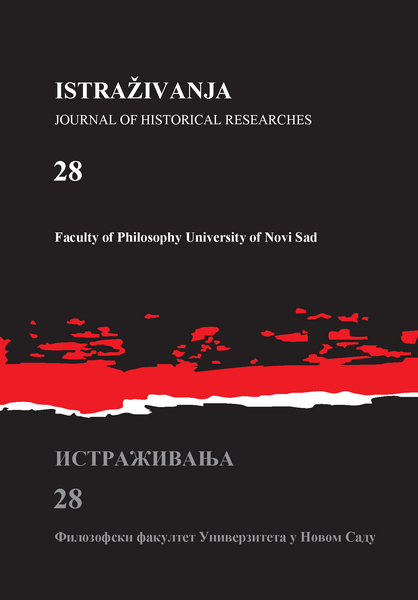SCORCHED EARTH: VIOLENCE AND LANDSCAPE IN NEW KINGDOM EGYPTIAN REPRESENTATIONS OF WAR
DOI:
https://doi.org/10.19090/i.2017.28.7-28Keywords:
violence, war, landscape, New Kingdom, Egypt, Syria-Palestine, NubiaAbstract
Death and destruction of peoples and lands are the reality of war. Since the Old Kingdom the destruction of enemy landscape is attested in Egyptian written sources and the number of attestations increases in the following periods, culminating in the New Kingdom. This is also the period when the first visual attestations of enemy landscape destruction appear. In this paper I will explore the actors, targets and acts concerning violence against enemy landscapes together with the use of landscape elements as metaphors for the violent treatments of enemies during the New Kingdom. The study shows that there are differences in representations of treatments of Syro-Palestinian and Nubian landscapes, which could be related to the reality of war itself, as monumental enemy fortresses did not exist in Upper Nubia, at least not on the same scale as in Syria-Palestine. This real difference went hand in hand with the ancient Egyptian construction of the Other as unsettled. Thus, urban landscapes of Syria-Palestine are objects of violence in the visual record where they are reduced to unsettled landscapes through destruction and desolation. It is also shown that this reality of war is additionally framed through Egyptian rules of decorum ascribing most of the destructions of landscape to the king and only some to the soldiers.
Downloads
References
Ahrens, A. ʽZur Bedeutung und Funktion von Tellstrukturen in den Feldzugsdarstellungen des Neuen Reichesʼ. Göttinger Miszellen, 248, 2016, 27-38.
Aufrère, S. J. ‘La destruction des arbres et des cultures des villes à l’occasion d’un siege’, in: S. H. Aufrère (éd.), Encyclopédie religieuse de l’Univers végétal. Croyances phytoreligieuses de l’Égypte ancienne Volume III, Orientalia Monspeliensia XV, Montpellier: Université Paul Valéry, 2005, 49–57.
Bader, B. ʽCultural Mixing in Egyptian Archaeology: The 'Hyksos' as a Case Study’, in: W. P van Pelt (ed.), Archaeology and Cultural Mixture. Archaeological Review from Cambridge 28.1. Cambridge: Archaeological Review from Cambridge, 2013, 257–286.
Baines, J. ‘Restricted Knowledge, Hierarchy, and Decorum: Modern Perceptions and Ancient Institutions’, Journal of American Research Centre in Egypt, XXVII, 1990, 1–23.
______. High Culture and Experience in Ancient Egypt. Sheffield and Bristol: Equinox, 2013.
Beaux, N. Le cabinet de curiosités de Thoutmosis III. Plantes et animaux du «Jardin botanique» de Karnak. Orientalia Lovaniensia Analecta 36. Leuven: Uitgeverij Peeters, 1990.
Bietak, M., Dorner, J., und Jánosi, P. “Ausgrabungen in dem Palastbezirk von Avaris. Vorbericht Tell el-Dabca/cEzbet Helmi 1993-2000,” Ägypten und Levante XI, 2001, 27–119.
Burke, A. A. ‘Canaan under Siege. The History and Archaeology of Egypt’s War in Canaan during the Early Eighteenth Dynasty’, in: J. Vidal (ed.), Studies on War in the Ancient Near East. Collected Essays on Military History, Altes Orient und Altes Testament 372, Münster: Ugarit Verlag, 2010, 43–66.
Borowski, O. ‘Animals in the Literatures of Syria-Palestine’, in: B. J. Collins (ed.), A History of the Animal World in the Ancient Near East, Handbook of Oriental Studies 64, Leiden: Brill, 2001, 289–306
Butler, J. Frames of War. When is Life Grievable?, London: Verso, 2009
Clausen, W. ‘The Scorched Earth Policy, Ancient and Modern’,The Classical Journal, 40 (5), 1945, 298–299.
Cole, S. W. ‘The Destruction of Orchards in Assyrian Warfare’, in: S. Parpola and R. M. Whiting (eds.), Proceedings of the 10th Anniversary Symposium of the Neo-Assyrian Text Corpus Project Helsinki, September 7-11, 1995, Helsinki: The Neo-Assyrian Text Corpus Project, 1997, 29–40.
Erman, A. und Grapow, H. Wörterbuch der ägyptischen Sprache, Band I-V, Berlin: Akademie Verlag, 1926=Wb.
Feldman, M. ‘Nineveh to Thebes and Back: Art and Politics between Assyria and Egypt in the Seventh Century BCE’, Iraq 66, 2004, 141–50.
Fischer-Elfert, H. W. ʽSedentarism and Nomadism as Criteria of Ancient Egyptian Cultural Identity’, in: S. Leder and B. Streck (eds.), Shifts and Drifts in Nomad-Sedentary Relations. Nomaden und Sesshafte 2, Wiesbaden: Dr. Ludwig Reichert Verlag, 327–350.
Gaballa, A. G. Narative in Egyptian Art. Mainz: Philipp von Zabern, 1976.
Galter, H. D. ‘Die Landschaft als Feind. Schlachtfelder in der assyrischen Geschichtsschreibung’. Schield von Steier 27, 2016, 18–27.
Germer, R. Flora des pharaonischen Ägypten. Sonderschriften des Deutschen Archäologischen Institus Abteilung Kairo 14. Mainz am Rhein: Verlag Philipp von Zabern, 1985.
Habachi, L. The Second Stela of Kamose and his Struggle against the Hyksos Ruler and his Capital. Abhandlungen des Deutschen Archäologischen Instituts Kairo Ägyptologische Reihe 8. Glückstadt: Verlag J. J. Augustin, 1972.
Hanson, V. D. Warfare and Agriculture in Classical Greece. Revised Edition, Biblioteca di Studi Antichi 40, Berkeley: University of California Press, 1998.
Harvey, S. P. The Cults of King Ahmose at Abydos, University of Pennsylvania, 1998.
Hasel, M. G. Domination and Resistance: Egyptian Military Activity in the Southern Levant, 1300-1185 BC, Probleme der Ägyptologie XI, Leiden: Koninklijke Brill, 1998.
Heinz, S. C. Die Feldzugdarstellungen des Neuen Reiches. Eine Bildanalyse, Untersuchungen der Zweigstelle Kairo des Österreichsischen Archäologischen Institutes XVII, Wien: Verlag der Österreichischen Akademie der Wissenschaften, 2001.
Helck, H. W. Urkunden der 18. Dynastie. Text der Häfte 17-22. 3 Bde, Urkunden des Aegyptischen Altertums IV, Berlin: Akademie Verlag, 1984=Urk IV.
Hoffmeier, J. K. Israel in Egypt. The Evidence for the Authenticity of the Exodus Tradition, Oxford: Oxford University Press, 1997.
Hsu, S-W. ‘Figurative Expressions Referring to Animals in Royal Inscriptions of the 18th Dynasty’, Journal of Egyptian History 6, 2013, 1–18.
______. ʽCaptured, Defeated, Tied and Fallen: Images of Enemies in ancient Egyptʼ, Göttinger Miszellen, 252, 2017, 71-87.
Janssen, J. M. ʽThe Stela (Khartoum Museum No. 3) from Uronarti’, Journal of Near Eastern Studies XII 1953: 51–58.
Keel, O. Vögel als Boten. Studien zu Ps 68, 12-14, Gen 8, 6-12, Koh 10, 20 und dem Aussenden von Botenvögeln in Ägypten. Mit einem Beitrag von Urs Winter zu Ps 56,1 und zur Ikonographie der Göttin mit der Taube, Orbis Biblicus et Orientalis 14, Freiburg: Universitätsverlag, 1977.
______. ‘Eine Festung mit Vögeln’, in: S. Israelit-Groll (ed.), Studies in Egyptology presented to Miriam Lichtheim II. Jerusalem: The Magnes Press, 1990, 625–631.
Kitchen, K. Ramesside Inscriptions. Historical and Biographical I, Oxford: Blackwell, 1975=KRI I.
______. Ramesside Inscriptions. Historical and Biographical II. Oxford: Blackwell, 1979=KRI II
______. Ramesside Inscriptions. Historical and Biographical IV, Oxford: Blackwell, 1982= KRI IV.
______. Ramesside Inscriptions. Historical and Biographical V. Oxford: Blackwell. 1983= KRI V
Krug, E. G., Dahlberg, L. L., Mercy, J. A., Zwi, A. B. and Lozano R. (eds.) World report on violence and health, Geneva: World Health Organisation, 2002.
Lundh, P. Actor and Event. Military Activity in Ancient Egyptian Narrative Texts from Tuthmosis to Merenptah. Uppsala: Akademitryck, 2002.
Manassa, C. Imagining the Past. Historical Fiction in New Kingdom Egypt, Oxford: Oxford University Press, 2013.
Matić, U. ‘Enemies Hanged Upside (Head) Down’, in: M. Tomorad and J. Popielska-Grzybowska (eds.), Egypt 2015: Perspectives of Research Proceedings of the Seventh European Conference of Egyptologists 2nd-7th June 2015, Zagreb, Croatia, Oxford: Archaeopess, 2017a, 319–327.
______. ‘Traditionally Unharmed? Women and Children in NK Battle Scenes’, in: A. Kahlbacher and E. Priglinger (eds.), Proceedings of the 5th International Congress for Young Egyptologists, Vienna, 15-19 September 2015, Vienna: Austrian Academy of Sciences, 2017b, in press.
Meurer, G. ‘Das Motiv der „Verwüstung ausländischen Territoriums“, in Texten des Alten, Mittleren und Neuen Reiches’, in: C-B Arnst, I. Hafemann und A. Lohwasser (Hrsg.), Begegnungen. Antike Kulturen im Niltal. Festgabe für Erika Endesfelder, Karl-Heinz Priese, Walter Friedrich Reineke und Steffen Wenig von Schülern und Mitarbeitern, Leipzig: Verlag Helmar Wodtke und Katharina Stegbauer, 2001, 325–347.
Moers, G. ʽAuch der Feind war nur ein Mensch. Kursorisches zu einer Teilansicht pharaonischer Selbst- und Fremdwahrnehmungsoperationen’, in: H. Felber (Hrsg.) Feinde und Aufrührer Konzepte von Gegnerschaft in ägyptischen Texten besonders des Mittleren Reiches. Abhandlungen der Sächsischen Akademie der Wissenschaften zu Leipzig 78, 5. Stuttgart/Leipzig: S. Hirzel Verlag, 2005, 223–282.
Moers, G. ʽThe World and the Geography of Otherness in Pharaonic Egypt’, in: K. A. Raaflaub and R. J. A. Talbert (eds.), Geography and Ethnography-Perceptions of the World in Pre-Modern Societies. Oxford: Wiley-Blackwell, 2010, 169–181.
Monnier, F. ‘Une iconographie égyptienne de l’architecture défensive’Égypte Nilotique et Méditerranéenne 7, 2014, 173–219.
Müller, M. ‘Bildliche Quellen zur Militärgeschichte’, in: R. Gundlach und C. Vogel (Hrsg.) Militärgeschichte des pharaonischen Ägypten. Altägypten und seine Nachbarkultur im Spiegel aktueller Forschung, Paderborn: F. Schöning, 2009, 217–242.
______. ‘Der Lebende Horus auf dem Schlachtfeld’,Kemet. Die Zeitschrift für Ägyptenfreunde, 22 (1), 2013, 15–18.
Parkinson, R. B. ʽNow, Voyager: a preface on the poetics of place’, in: C. Alvarez, A. Belekdanian, A-K Gill and S. Klein (eds.), Current Research in Egyptology 2015. Proceedings of the Sixteenth Annual Symposium University of Oxford 2015, Oxford and Philadelphia: Oxbow Books, 1–19.
Partridge, R. B. Fighting Pharaohs. Weapons and Warfare in Ancient Egypt. Manchester: Peartree Publishing, 2002.
Quack, J. F. ‘How unapproachable is a Pharaoh?’, in: G. B. Lanfranchi and R. Rollinger (eds.), Concepts of Kingship in Antiquity. Proceedings of the European Science Foundation Exploratory Workshop held in Padova, November 28th – December 1st, 2007, History of Ancient Near East XI, Padova: S.A.R.G.O.N Editrice e Libreria, 2010, 1–14.
Redford, D. B. Wars in Syria and Palestine of Thutmose III. Culture and History of the Ancient Near East 16, Leiden: Brill, 2003.
Richardson, S. ‘Insurgency and Terror in Mesopotamia’, in: T. Howe (ed.), Brill's Companion to Insurgency and Terrorism in the Ancient Mediterranean. Brill's Companions in Classical Studies Online III, Leiden: Brill, 2015, 29–61.
Rivnay, E. Field Crop Pests in the Near East, Monographiea Biologicae X, Dordrecht: Springer Science, 1962.
Schröder, I.W and Schmidt, B. E. ‘Introduction: Violent imaginaries and violent practices’, in: I. W. Schröder and B. E. Schmidt (eds.), Anthropology of Violence and Conflict, London: Routledge 2001, 1–24.
Schulz, R.‘Remarks on the Composition of Hunting and Battle Scenes on the Chest of Tutankhamun’ In S. Sherratt (ed.) The wall paintings of Thera: proceedings of the first international symposium : Petros M. Nomikos Conference Centre, Thera, Hellas, 30 August-4 September 1997. Volume I, Athens: Thera Foundation, 2000, 247–266.
Sethe, K. H. Urkunden der 18. Dynastie. Text der Häfte 1-16. 4 Bde, Urkunden des Aegyptischen Altertums IV, Berlin-Graz: Akademie Verlag, 1961=Urk IV.
Smith, H. S. The Fortress of Buhen. The Inscriptions. Egypt Exploration Society Excavation Memoir 48. London: Egypt Exploration Society, 1976.
Strudwick, N. C. Texts from the Pyramid Age. Writings from the Ancient World 16. Atlanta: Society for Biblical Literature, 2005.
Spalinger, A. J. Aspects of the Military Documents of the Ancient Egyptians, Yale Near Eastern Researches 9, New Haven: Yale University Press, 1982.
______. War in Ancient Egypt. The New Kingdom, Oxford: Blackwell, 2005.
______. Icons of Power. A Strategy of Reinterpretation, Prague: Faculty of Arts, Charles University in Prague, 2011.
______. ʽEgyptian New Kingdom Triumphs: A First Blush’, in: A. J. Spalinger and J. Armstrong (eds.), Rituals of Triumph in the Mediterranean World. Culture & History of the Ancient Near East 63. Leiden and Boston: Brill, 2013, 95–122.
Thorne, J. A. ‘Warfare and Agriculture: The Economic Impact of Devastation in Classical Greece’, Greek, Roman, and Byzantine Studies 42, 2001, 225–253.
Tilley, C. A Phenomenology of Landscape. Places, Paths and Monuments, Oxford: Berg, 1994.
Vogel, C. ʽStorming the Gates? Entrance Protection in the Military Architecture of Middle Kingdom Nubia’, in: M. Bietak, E. Czerny and I. Forstner-Müller (eds.), Cities and Urbanism in Ancient Egypt. Untersuchungen der Zweigstelle Kairo des Österreichischen Archäologischen Institutes XXXV. Wien: Verlag der Österreichischen Akademie der Wissenschaft, 2010, 299–320.
Wattler, M. ‘Menschliche Körperteile in der Architektur und Landschaft des Alten Ägypten’, in: S. Beck, B. Backes, I-T. Liao, H. Simon und A. Verbovsek (Hrsg.),Gebauter Raum: Architektur – Landschaft – Mensch. Beiträge des fünften Münchner Arbeitskreises Junge Aegyptologie (MAJA 5) 12.12. bis 14.12.2014, Göttinger Orientforschungen 62, Wiesbaden: Harrassowitz Verlag, 2016, 211–222.
Wreszinski, W. Atlas zur altaegyptischen Kulturgeschichte. Teil II, Leipzig: J. C. Hinrichs, 1935.
Wreszinski, W., Ranke, H. und Burchardt, M. Ägyptische Inschriften aus den Königlichen Museen zu Berlin. Erster Band. Inschriften von der ältesten Zeit bis zum Ende der Hyksoszeit. Leipzig: J. C. Hinrichssche Buchhandlung, 1913.
Žába, Z. The Rock Inscriptions of Lower Nubia (Czechoslovak Concession). Charles University of Prague Czechoslovak Institute of Egyptology in Prague and in Cairo Publications 1. Prague: Charles University of Prague, 1979.
Žižek, S. Violence. Six Sideways Reflections, New York: Picador, 2008.










